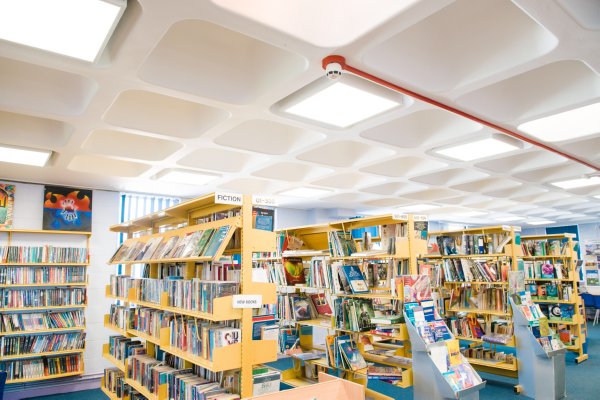Choosing the Healthiest Lighting for Schools
Written by Tim Greenhalgh
Posted on August 8, 2018
Why LED is a better solution than fluorescent lighting for children and staff

Fluorescent lighting in schools is more than just an irritation for many – it can be a serious issue for those with autism, epilepsy and migraine sufferers.
Apart from flickering seen in fluorescent lamps with magnetic ballasts, these have also been linked to a wide range of conditions, including headaches, fatigue, blurred vision, eyestrain and reduced performance, according to the US Department of Energy.
Given that fluorescent tube lighting in general is associated with negative physical effects, it makes sense to minimise or remove flicker when lighting classrooms and other school buildings by choosing well-manufactured LED lighting from trusted brands.
But it is important to work with an expert lighting provider to survey and source the most suitable quality products – there are reports of some budget LED tube lights emitting flicker due to the poor quality of the ballasts.
Lighting for children
While more recent types of fluorescent tube have reduced flicker, all emit a flicker that could trigger a seizure in those affected by photosensitive epilepsy and have effects on the behaviour of children with autism.
The issue of flicker is complex as many fluorescent tube manufacturers insist that their products have removed the problem. For some medical experts, the issue is still there, even if the tubes do not visibly appear to flicker. There are wider issues affecting fluorescent lighting.
Dr Victoria Dunkley is an award-winning child psychiatrist who specialises in working with children who have complex mental health conditions.
In an article for Psychology Today, Dr Dunkley argues that we should err on the side of caution when lighting environments for children and avoid the risk of triggering a range of reactions.
She advises that current data needs to be strengthened with more studies into effects of fluorescent lighting on neurological or psychiatric conditions to provide definitive arguments.
Colour spectrum
But she is clear that there is solid evidence the fluorescent lighting induces a stress response while a few studies indicate this lighting can trigger repetitive behaviour or hyperactivity in autistic children.
There is a strong body of research that identifies stress effects from fluorescent lighting, from stronger “startle response” and higher heart rate variability to raised blood pressure.
The colour spectrum emitted by fluorescent lighting is also seen by some researchers as an issue. The spectrum is classified as “spiky” with the strongest spikes in the ultra-violet, blue, yellow, orange and red regions.
There is some data that indicates the particular colour spiking properties of fluorescents can confuse the brain and affect its ability to correctly process colours. In contrast, LED tube lighting matches more closely the natural spectrum of sunlight with very few spikes.
This could affect those with autism and other neurological conditions, with research suggesting that the colour spiking triggers erratic constriction/dilation of the pupils that agitate the brain.
Photosensitive epilepsy
Photosensitive epilepsy is a condition where flickering or flashing light triggers a seizure. The condition is most commonly identified first between the ages of seven and 19 with more girls than boys affected. Around three in 100 people with epilepsy have photosensitive epilepsy, according to Epilepsy Action.
While mains-powered fluorescent lighting has a flicker rate (100-120Hz) that reduces conditions that may trigger seizures, any faulty tube could be a problem by emitting a lower rate flicker, so the potential hazard is always present as tubes and ballasts degrade over time.
In contrast, LED tubes from quality manufacturers not only have a very long working life, they also will not flicker at any point during their lifecycle.
Migraines
The Migraine Trust advises that while 70% of school children suffer a headache at least once a year, one in four have recurrent headaches and around one in 10 have migraines.
The condition affects both girls and boys, with about half of sufferers having an initial migraine before the age of 12.
The effect of fluorescent lighting is highlighted in The Complete Guide to Asperger’s Syndrome. A patient, Carolyn describes her reaction:
“With fluorescent lights it’s not only the glare that gets me, it’s the flicker as well. It produces shadows in my vision (which were very scary when I was young) and long exposure can lead to confusion and dizziness often resulting in migraines.”
It is also suggested that migraine sufferers become sensitised to fluorescent lighting, sometimes after an attack, and so are more prone to be affected by worrying about the potential trigger.
LED advantages
While it’s important to select LED lighting that is well manufactured, the benefits are numerous. Flicker-free LED solutions will be clearly better for the health and well-being of everyone, beyond those most susceptible to effects of poor quality lighting.
Apart from these health benefits, quality LED lighting improves the learning environment while reducing energy costs substantially and lowering carbon emissions. The very long life of well-produced LED lamps also ensures lower maintenance costs and risk.